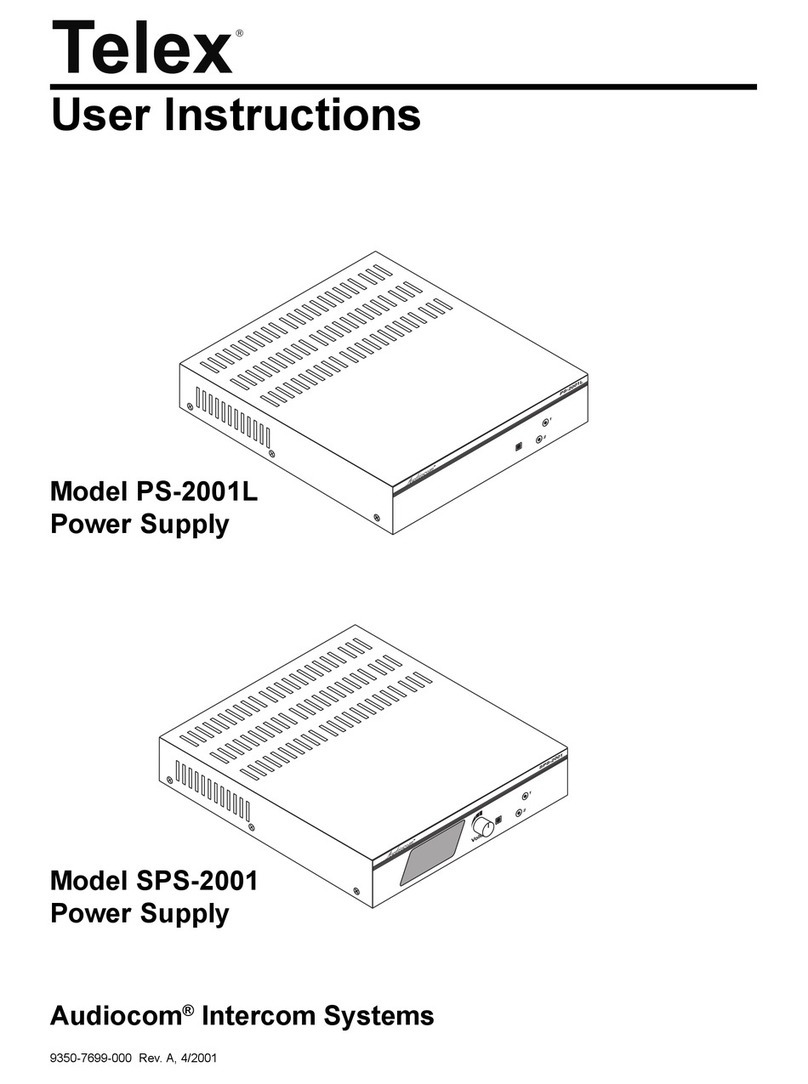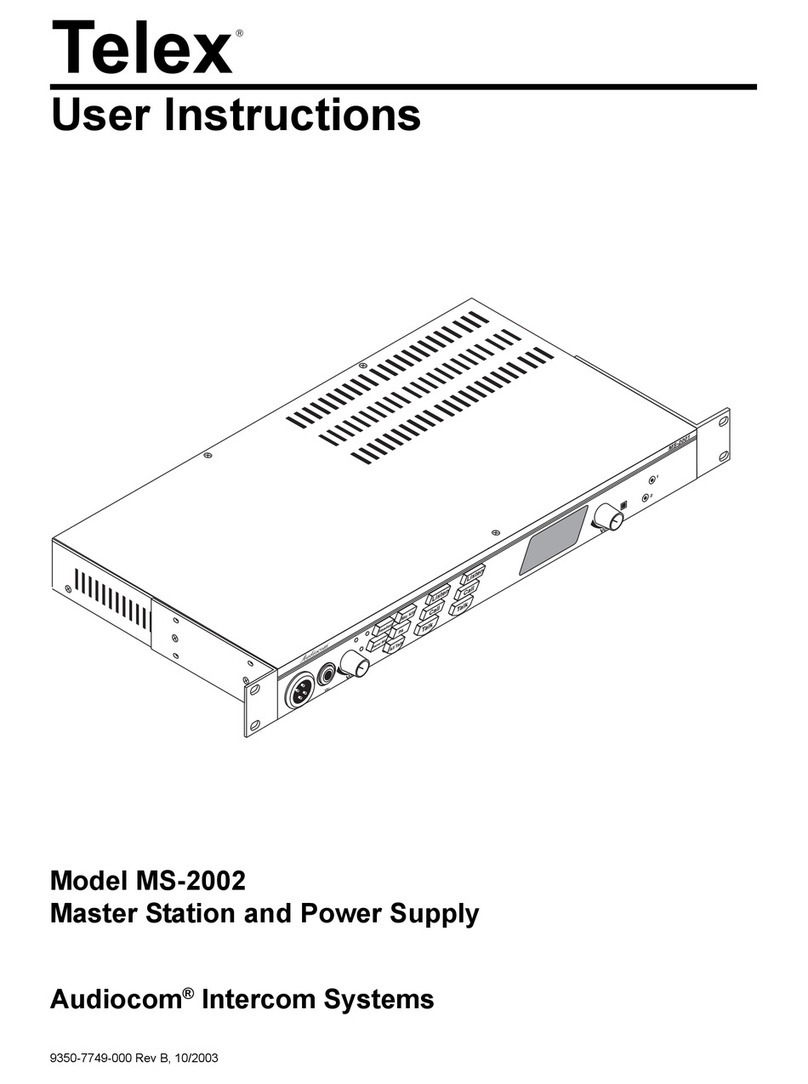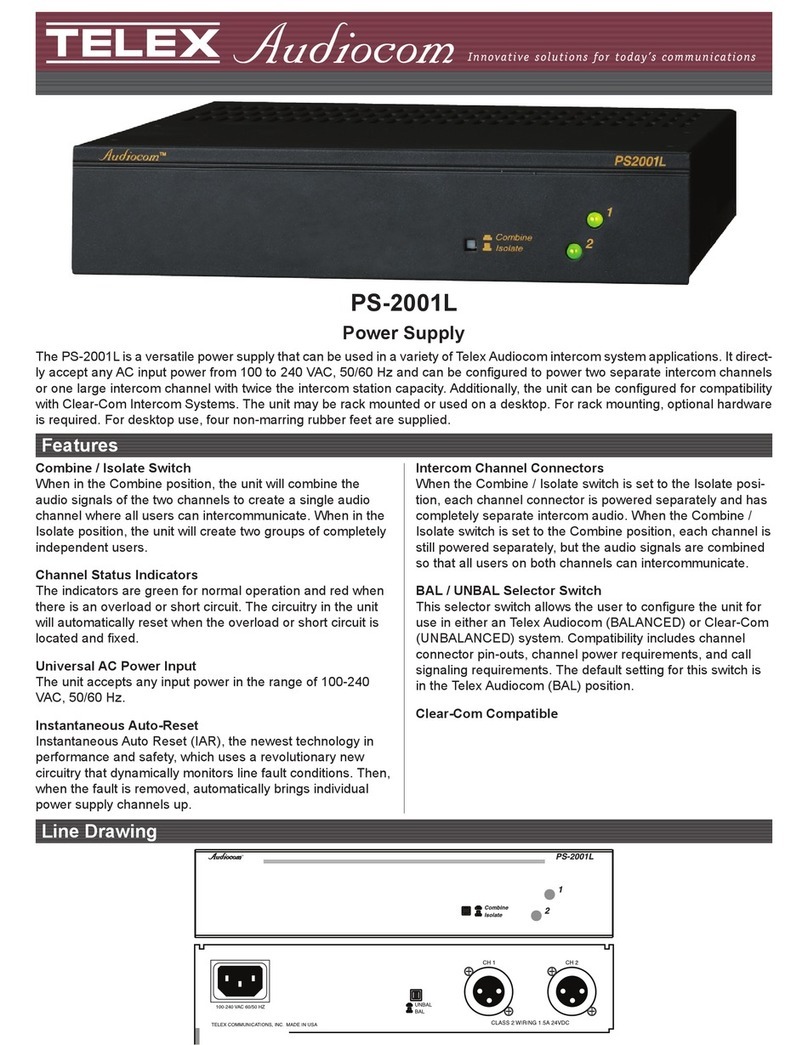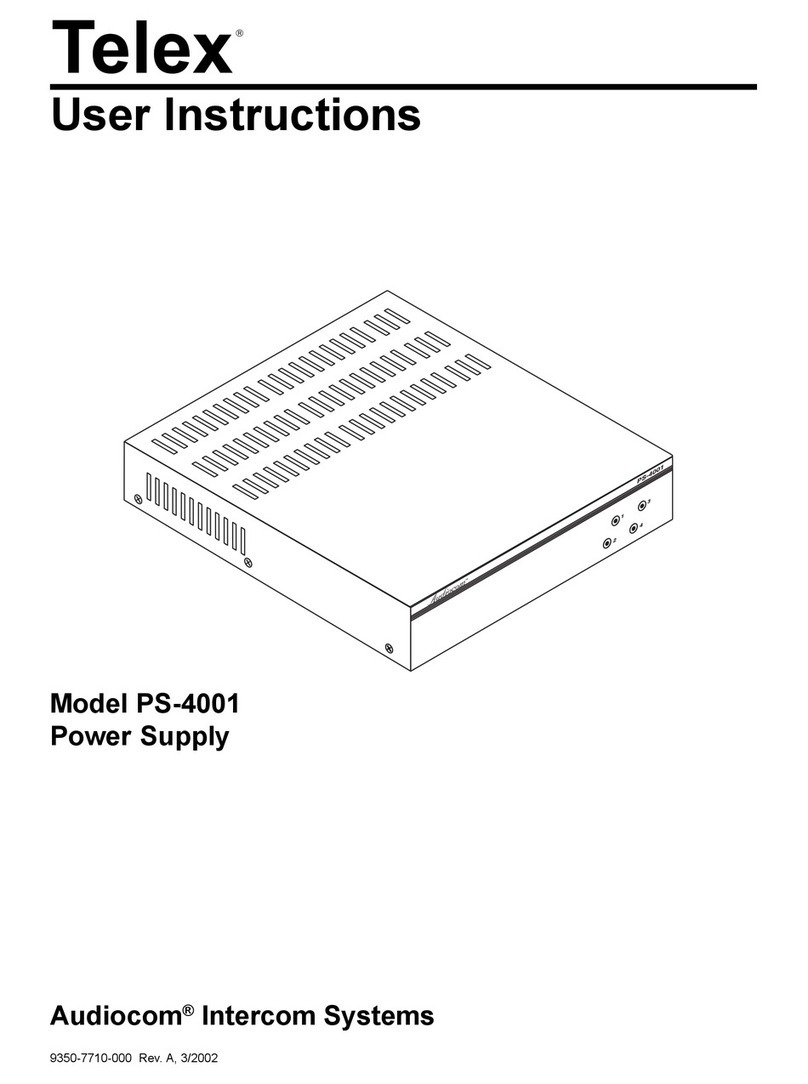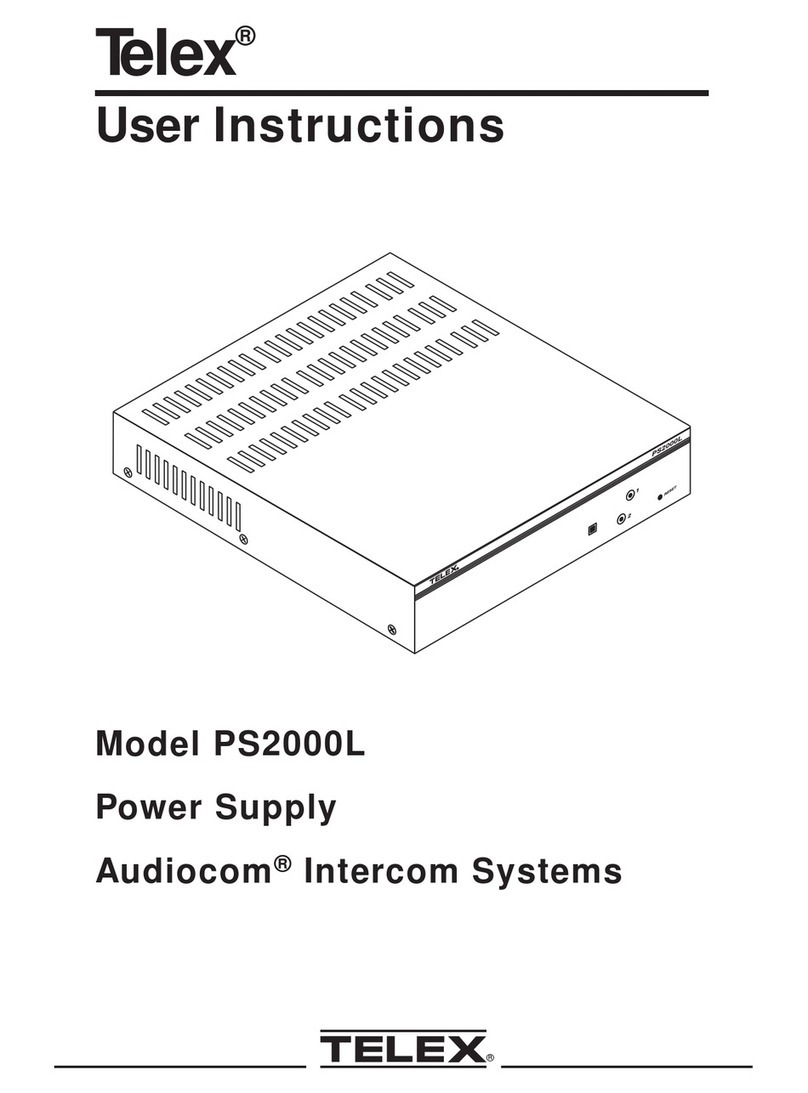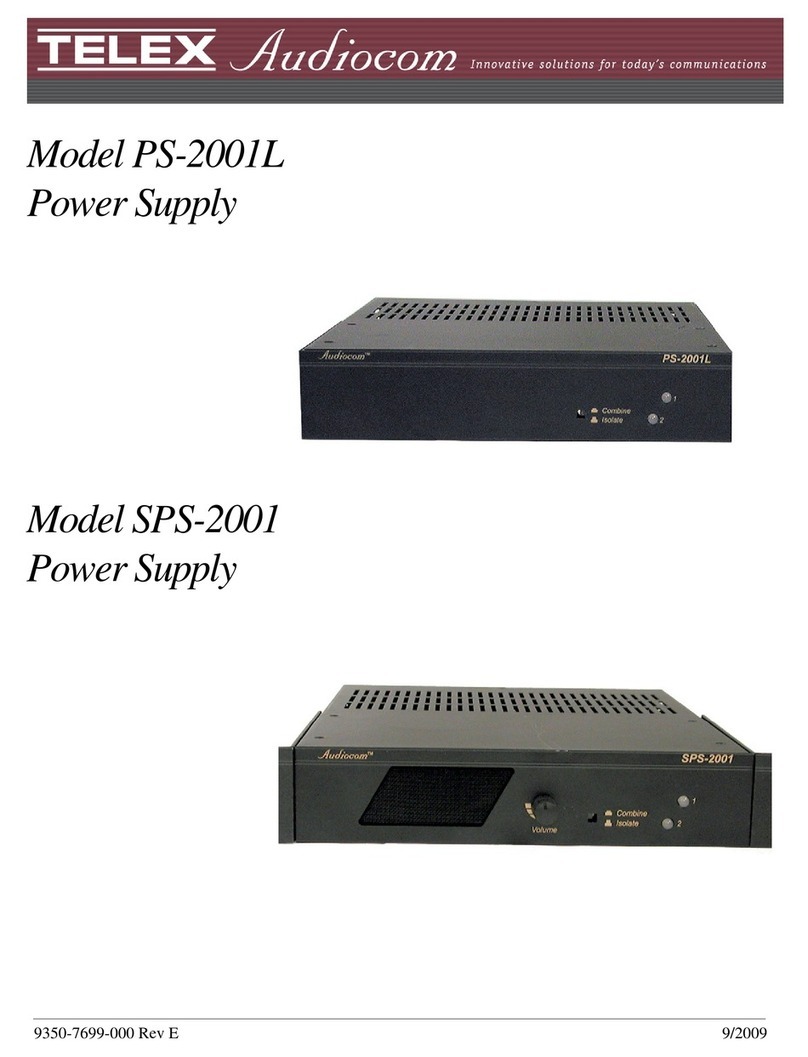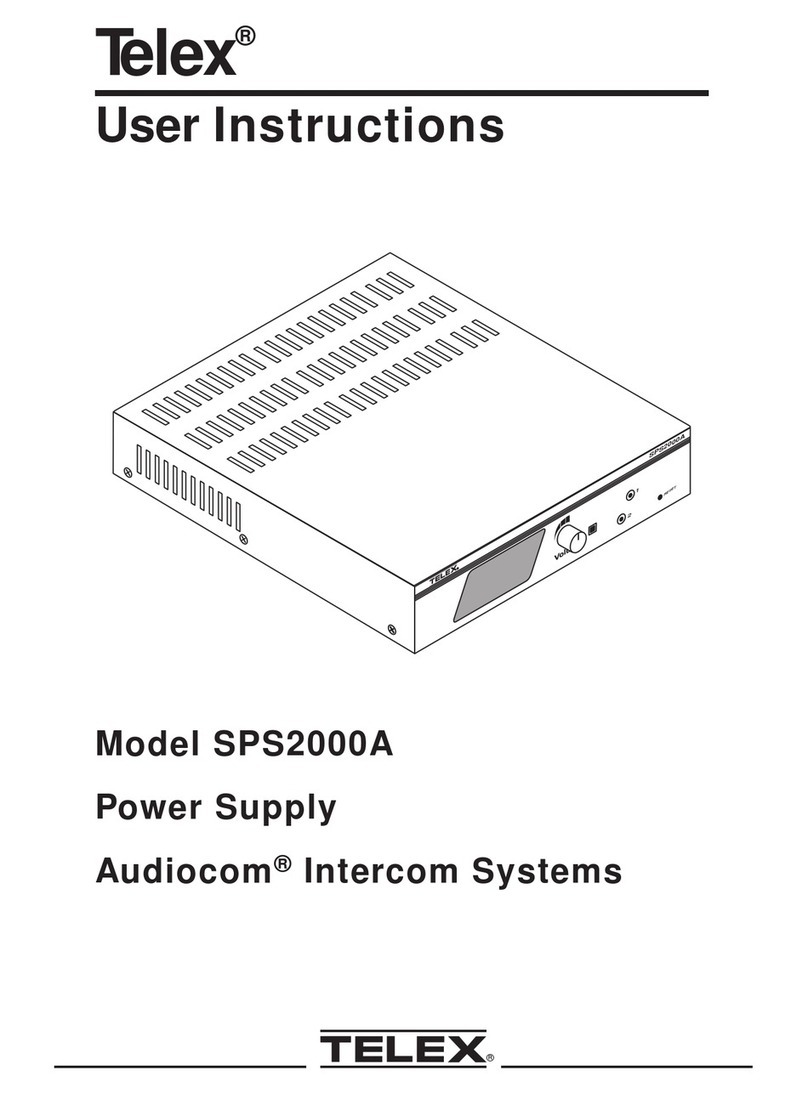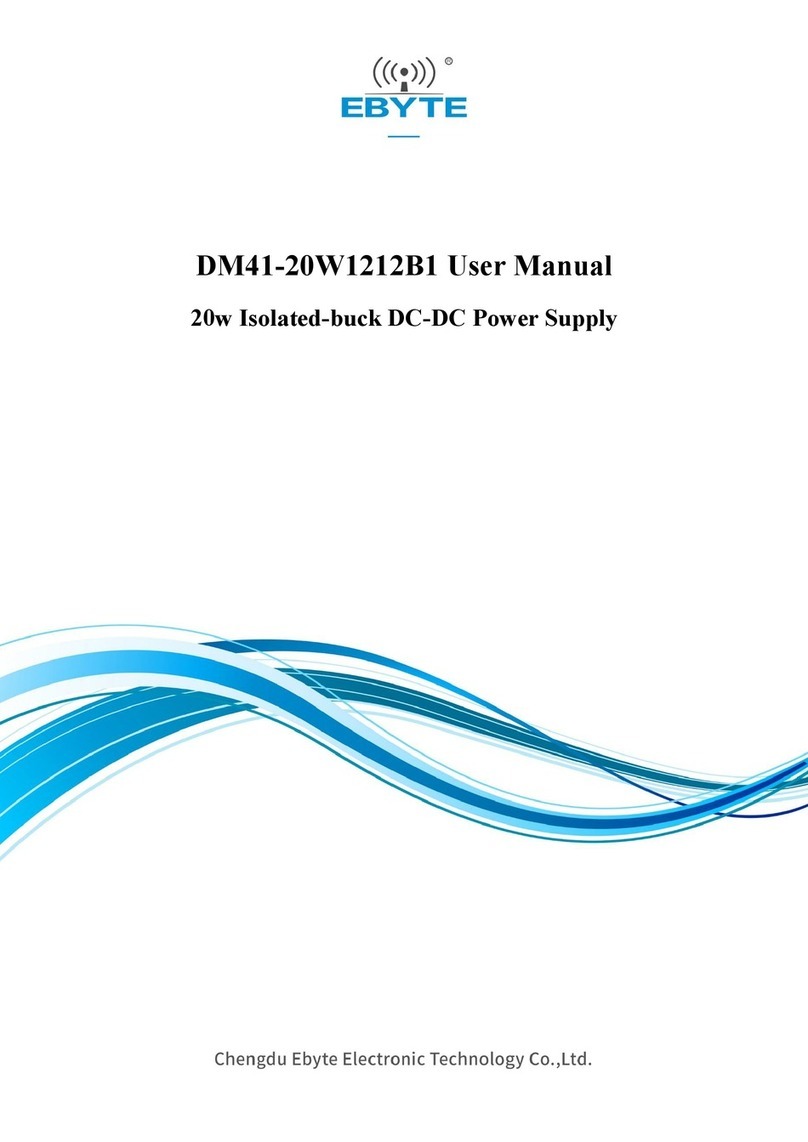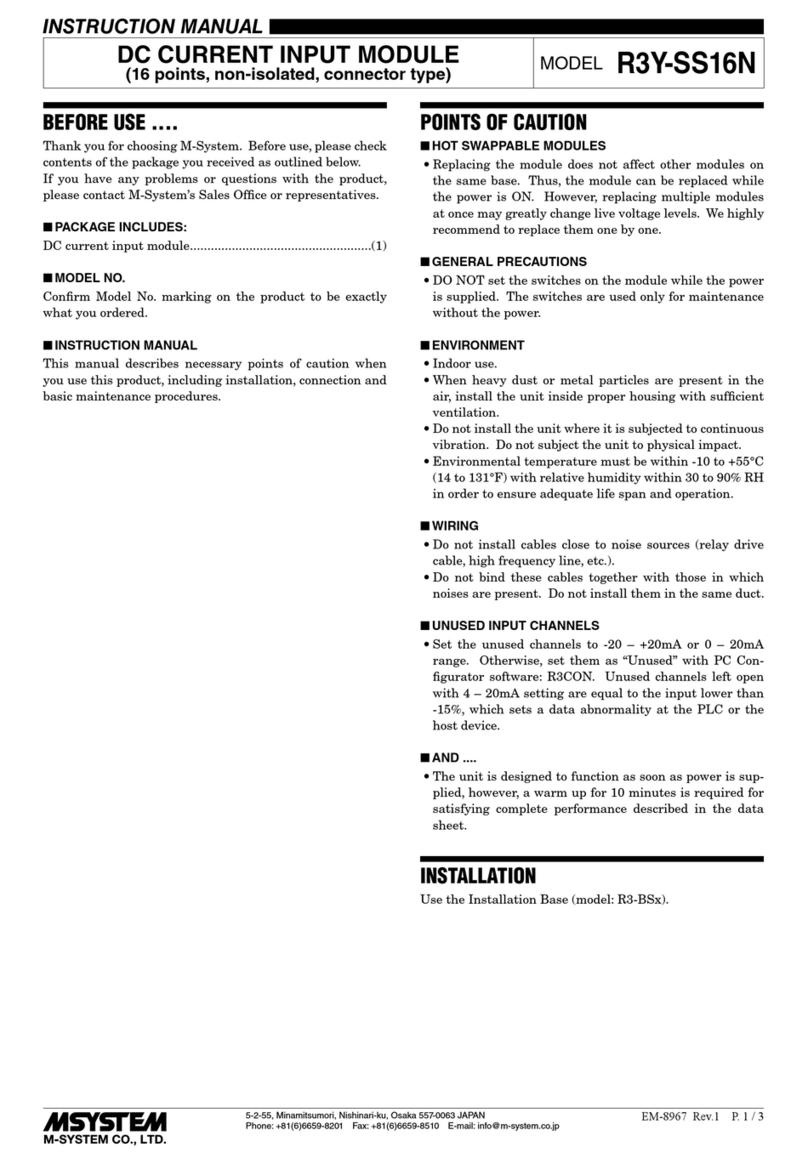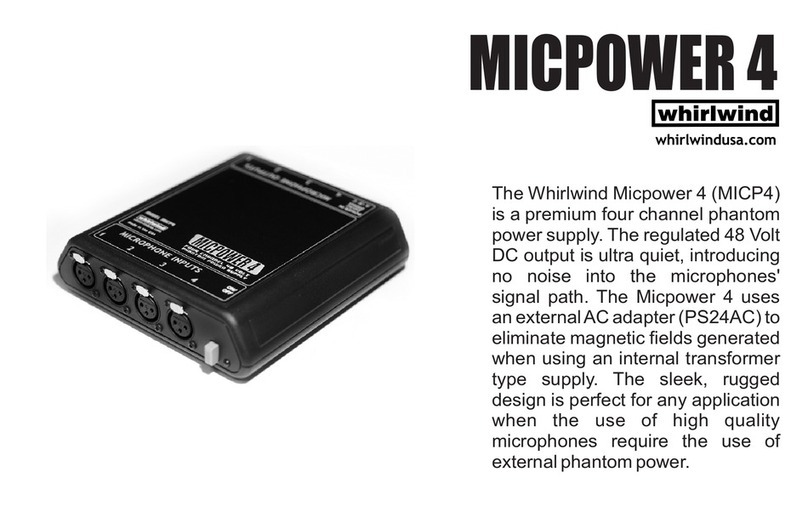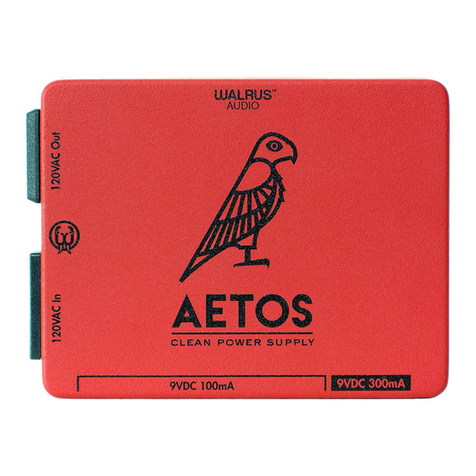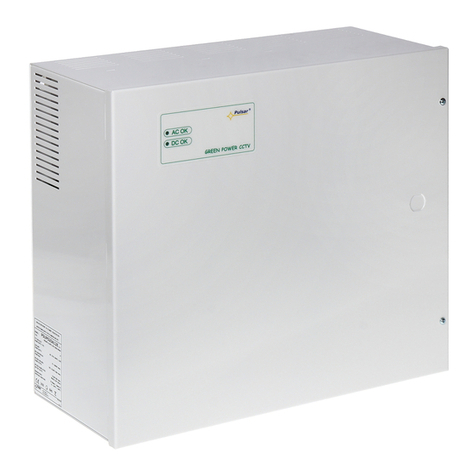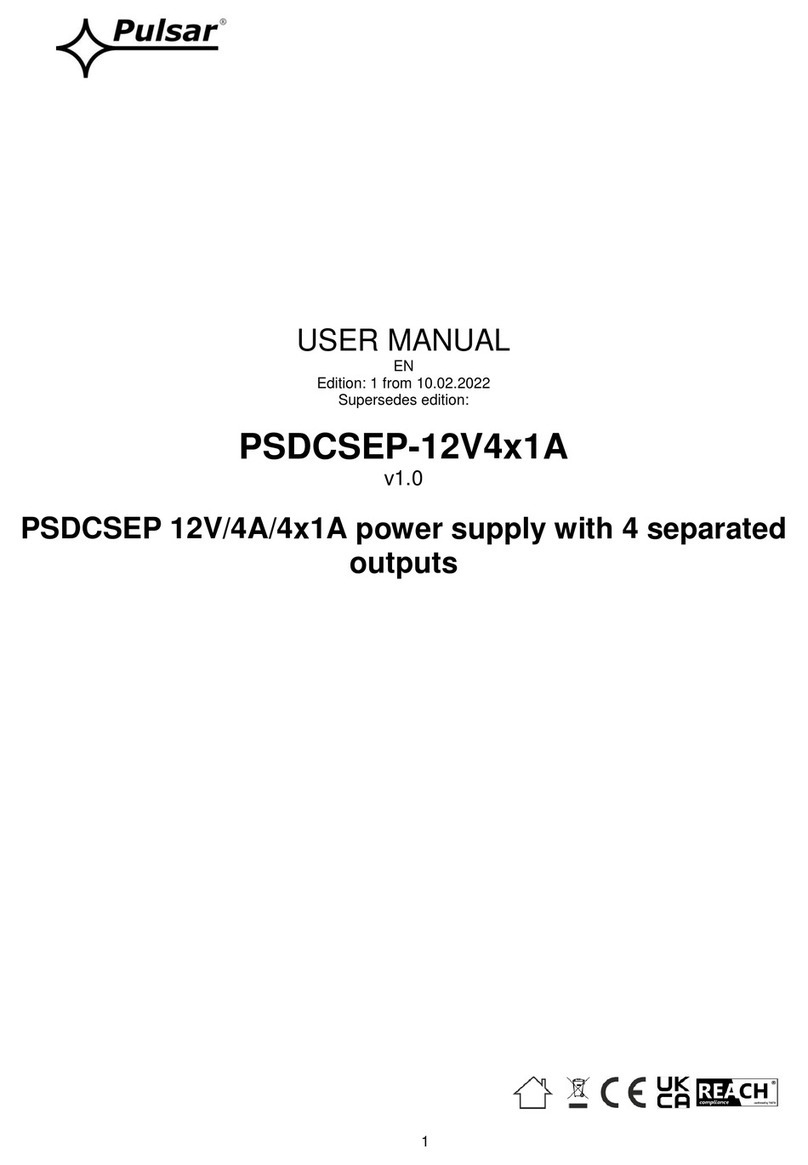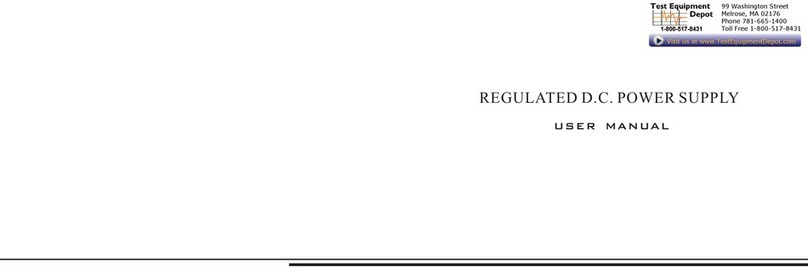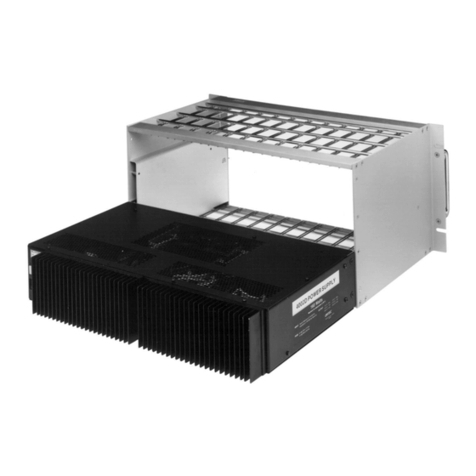Telex EMS4000 User manual

Telex®
User Instructions
Model EMS4000
Four-channel Expansion Master
Station and Power Supply
Audiocom®Intercom Systems
®
RESET
5
3
6
4
EMS4000
™
Listen
Call
Talk
Listen
Call
Talk
Listen
Call
Talk
Listen
Call
Talk

FCC Statement
This equipment uses and can radiate radio frequency energy that may cause in-
terference to radio communications if not installed in accordance with this man-
ual. The equipment has been tested and found to comply with the limits of a
Class A computing device pursuant to Subpart J, Part 15 of FCC Rules which
are designed to provide reasonable protection against such interference when op-
erated in a commercial environment. Operation of this equipment in a residential
area may cause interference which the user (at his own expense) will be required
to correct.
This product meets Electromagnetic Compatibility Directive 89/336/EEC.
Introduction.
Thank you for purchasing the Audiocom EMS4000 Four-channel Expansion
Master Station and Power Supply. We hope the many design features of this
product will satisfy your intercommunication requirements for many years to
come. To get the most out of the EMS4000, please take a few moments to look
through this booklet before using the Intercom Expansion Station for the first
time.
2

Table of Contents
Description .............4
Features ..............5
Installation .............7
Unpacking ............7
Configuration Pre-check ..........7
Mounting Configurations .........10
Connection Notes ...........14
Cables .............14
Power-Up ............15
Sidetone Adjustments ..........15
Operation .............15
Specifications ............16
Factory Service and Parts Information .......18
3

Description
The EMS4000 adds four powered intercom channels to an MS2000 Master Station,
and it provides talk, listen and call buttons for the added channels. Up to 4 EMS4000
Expansion Master Stations may be connected to the MS2000 to add up to 16 chan-
nels (18 channels total). The MS2000 microphone is used to talkback to the
EMS4000 channels, and the MS2000 speaker is typically used for listening. How-
ever, there are also separate speaker jacks on the back panel of the EMS4000 for in-
dependent monitor speakers, if desired. There are also 4 additional program inputs
on the back of the EMS4000, 1 for each added channel.
The MS2000 / EMS4000 combination can be used as a simple, multi-channel intercom
user station. In this configuration, the program inputs (and possibly the PA output of
the MS2000) are most likely not used, and the station operator has only talk, listen and
call capability. It is also possible that advanced features of the MS2000, such as Mic
Kill Send, might be turned off. Alternatively, the MS2000 / EMS4000 can be used as a
master station. In this application, one or more program inputs and the PA output may
be connected, and the program signals to the intercom channels can be turned on or off
from the MS2000. Additionally, the Mic Kill Send feature can be enabled, and micro-
phones on any channels may then be turned off from the MS2000.
4
Audiocom®
345 6
3
4
5
6
EMS4000
CHN3 CHN4 CHN5 CHN6
CLASS 2 WIRING 1.5 A 24 VDC
EXP
IN
EXP
OUT
35
46
LINE LEVEL
1VRMS
BAL-OUT
UNBAL-IN
SPEAKER
PGM VOL
3456
TELEX COMMUNICATIONS, INC.
MADE IN USA
100-240 VAC 60/50 HZ
Reset
123 45
6 7 8 9 10 11
PROGRAM
INPUTS
®
Listen
Call
Ta l k
Listen
Call
Ta l k
Listen
Call
Ta l k
Listen
Call
Ta l k
Figure 1. ES4000A Reference View (See numbered features on next page)

Features
1. Intercom Talk Keys: Momentary or latching (hands-free) operation possible.
2. Call Keys: Used to call intercom channels and to indicate incoming calls.
3. Intercom Listen Keys: Momentary or latching operation possible.
4. Channel Power Status Indicators: The indicators are green for normal operation
and change to red if there is a short circuit or overload condition on a power out-
put line. If an indicator turns red, either disconnect the corresponding channel
connector or turn off the intercom system and locate the problem before resum-
ing operation
5. Reset Button: Used to resume normal operation after an overload condition has
been corrected.
6. Universal AC Power Connector: Accepts a variety of international power cord
types.
7. Intercom Channel Connectors: These connectors provide the power and audio
connections for each of the 4 intercom channels.
8. EXP IN and EXP OUT Connectors: The EXP IN connector receives the micro-
phone audio signal from the MS2000, and it sends the monaural mix of the four
EMS4000 channels to the MS2000 speaker or headset. The EXP OUT connector
connects to the EXP IN connector of an additional EMS4000. Up to 4 EMS4000
Expansion Master Stations may be daisy chained with the EXP IN and EXP
OUT connectors. An EXP IN/OUT cable is supplied with each EMS4000.
9. SPEAKERS: Usually, the listen mix of all 4 EMS4000 channels is sent to the
MS2000 speaker or headset via the EXP IN connector. Alternatively, speakers
may be connected to one or more of the speaker outputs of the EMS4000.
10. BAL / UNBAL Switch: This selector switch sets the EMS4000 for compatibility
with either Audiocom or Clear-Com* channel connector pin-outs, channel
power requirements, and call signaling requirements. Important! The internal
switches S200 and S600 must be set the same as the back panel BAL/UNBAL
switch.
5
* Brand names mentioned are the property of their respective companies.

11. Program Inputs Connector and Trimmers: Each intercom channel has its own
program input and level adjust trimmer. For each program input, there is an inter-
nal jumper which routes the program either to the intercom channel only, or to
both the intercom channel and the MS2000 headset or speaker (default setting).
Additionally, the program signal to the intercom channel may be turned on or
off via the MS2000 front panel programming. There is also an internal program
interrupt DIP switch which selects either automatic program interrupt when the
station operator activates a channel's talk key, or no program interrupt during
talk. The EMS4000 program inputs connector may be broken out to common
3-pin XLR audio cables using an optional XP-4PGM Breakout Panel.
12. Configuration Switches, Jumpers and Sidetone Controls (Figure 2). These let
you customize the operation of the EMS4000 to match your intercom system re-
quirements. See “Configuration Pre-check”, page 7, for details.
6
Audiocom®
S600 S200
SW3
SW1
Ch 6
Ch 3
Ch 4
Ch 5
SW2
BAL / UNBAL
Sidetone
Trimmers
J21
321
J15
321
J16
321
J18
321
DIP Switches
Program
Listen
Jumpers
UNBAL
(CLEAR-COM)
(AUDIOCOM)
BAL
S200 & S600
MUST BE SET THE SAME
AS SW2 ON THE BACK PANEL.
FACTORY SETTING BAL
Figure 2. Locations of configuration switches, jumpers, and sidetone controls.
(Top cover removed.)

Installation
Unpacking
The EMS4000 is supplied with the following items. Contact the shipper or your
Audiocom dealer immediately if anything is damaged or missing. Detach and fill out
the registration card and return it to Telex to properly register your intercom station.
Quantity Description
1 EMS4000 Expansion Master Station and Power Supply
1 Warranty and registration card
1 User Instructions
1 EXP IN/OUT Cable, with 1/8-inch (3.5 mm) phone plugs
2 Rack Mount Cosmetic Covers
WARNING
The following instructions are for use by qualified personnel
only. To avoid electric shock, do not remove the cover un
less you are qualified to do so.
AVERTISSEMENT
Les instructions qui suivent s'adressent uniquement a un
technicien qualifie. Pour evite des chocs electriques, ne pas
ouvrir le boitier, a moins d'y entre habilite.
Configuration Pre-check
Before making connections, read the configuration notes that follow, and make sure
that all switches and jumpers are properly set for your intended usage. Locations of
configuration switches and jumpers are shown in Figure 2. Only the DIP switches
and jumpers require internal access. If access is required, remove 3 screws from the
top cover and 3 screws along the bottom edge from each side.
DIP Switches
DIP switches and their default settings are listed in Table 1, page 8. The following
paragraphs provide additional details.
7

Audiocom®
8
Switch
Number
Description Settings Default
Setting
DIP Switch SW1 (Internal)
SW1-1 Program Interrupt, Ch 6 On (Closed): Enabled
Off (Open): Disabled Off
SW1-2 Program Interrupt, Ch 5 On (Closed): Enabled
Off (Open): Disabled Off
SW1-3 Program Interrupt, Ch 4 On (Closed): Enabled
Off (Open): Disabled Off
SW1-4 Program Interrupt, Ch 3 On (Closed): Enabled
Off (Open): Disabled Off
SW1-5 Audiocom Call Send, Ch 3* On (Closed): Enabled
Off (Open): Disabled On
SW1-6 Audiocom Call Receive, Ch 3* On (Closed): Enabled
Off (Open): Disabled On
SW1-7 Audiocom Call Send, Ch 4* On (Closed): Enabled
Off (Open): Disabled On
SW1-8 Audiocom Call Receive, Ch 4* On (Closed): Enabled
Off (Open): Disabled On
Balanced (BAL) - Unbalanced (UNBAL) Operation
Important! All three switches must be set the same. Factory default is Balanced.
SW2 Audiocom or Clear-Com
operation
Out: Audiocom (Balanced)
In: Clear-Com (Unbalanced) Out (BAL)
S200
S600
Audiocom or Clear-Com
operation
BAL: Audiocom
UNBAL: Clear-Com BAL
DIP Switch SW3 (Internal)
SW3-1 Audiocom Call Send, Ch 5* On (Closed): Enabled
Off (Open): Disabled On
SW3-2 Audiocom Call Receive, Ch 5* On (Closed): Enabled
Off (Open): Disabled On
SW3-3 Audiocom Call Send, Ch 6* On (Closed): Enabled
Off (Open): Disabled On
SW3-4 Audiocom Call Receive, Ch 6* On (Closed): Enabled
Off (Open): Disabled On
SW3-5 Not used On (Closed): N/A
Off (Open): N/A Don’t care
SW3-6 Not used On (Closed): N/A
Off (Open): N/A Don’t care
SW3-7 Not used On (Closed): N/A
Off (Open): N/A Don’t care
SW3-8 Not used On (Closed): N/A
Off (Open): N/A Don’t care
*These switches apply only when the BAL/UNBAL switches SW2 (back panel), S200 and
S600 (both internal) are set to the BAL position for Audiocom usage (see Figure 2). When
the switches are set to the UNBAL position, call send and receive are always enabled.
Table 1. Configuration Switch Settings

Program Interrupt DIP Switches
Each intercom channel has a dedicated program input. These can be used to feed
background music, mix-minus audio (for broadcasting usage) etc. to the intercom
channels. If external program sources will be connected to the EMS4000, you have a
choice of whether or not you want the program audio to interrupt (shut off) on the in-
tercom channel while the MS2000A/EMS4000 station operator is talking.
Audiocom Call Send and Receive DIP Switches
By default, all channels of the EMS4000 can send and receive Audiocom call sig-
nals. You can disable call send or call receive capability for selected channels if de-
sired.
Balanced/Unbalanced Switches
The switches are located on the back panel ( SW2) and internal (S200 & S600).
These switches must be set to the balanced (BAL) position for use with an
Audiocom Intercom System. Set the switches to the unbalanced (UNBAL) position
when using the MS2000A / EMS4000 with a Clear-Com Intercom System. All
switches must be set the same.
Direct Program Listen Enable / Disable Jumpers
By default, each program input can be heard by intercom stations on the correspond-
ing intercom channel. (This can be turned on or off for each program input via the
MS2000 front panel programming. See "Turning the Program Inputs On and Off" in
the Operation section of the MS2000 User Instructions.) Additionally, all program
signals can be heard directly in the MS2000 speaker or headset, and each program is
output at the corresponding speaker jack on the back of the EMS4000. To disable di-
rect program listening for a program input, reset the appropriate jumper as shown in
Table 2. Locations of the jumpers are shown in Figure 2, page 6.
9
Jumper Description Settings for All Jumpers
J15 Program 3 direct to Headset or Speaker
Pins 2&3 Shorted: Enable
Pins 1&2 Shorted: Disable
J16 Program 4 direct to Headset or Speaker
J18 Program 5 direct to Headset or Speaker
J21 Program 6 direct to Headset or Speaker
Table 2. Direct Program Listen Enable / Disable Jumpers

Audiocom / RTS Select Jumpers.
These internal jumpers (W102 through W802) are for special applications which are
not applicable to the EMS4000. Leave the jumpers in the factory default position
(pins 2 & 3 shorted).
Sidetone Trimmers
These trimmers are normally adjusted after all components are connected, and they
can be accessed through the bottom cover (Figure 3). Refer to the MS2000 User
Manual for the sidetone adjustment procedure.
Mounting Configurations
The EMS4000 mounts in a standard 19 inch equipment rack and is 1 rack unit high.
Install the 2 supplied rack mount cosmetic covers when installing the EMS4000 in
the rack.
☞When rack mounting components, you may not be able to access the sidetone
trimmers after the components have been mounted. In this case, you can position
the components in the rack and make all required connections. Then, adjust the
sidetone trimmers before installing and tightening all rack mount screws.
10
Audiocom®
Ch 6
Sidetone
Ch 3
Sidetone
Ch 4
Sidetone
Ch 5
Sidetone
Figure 3. Sidetone Trimmer Access on Bottom of ES4000A

11
100-240 VAC60/50 HZ
2
SPEAKERS
PROGRAM
INPUTS
1
LINE LEVEL
1VRMS
P.A . EXP
OUT CHN 2
VOL
PGM 2
VOL
PGM 1
BAL - OUT
UNBAL - IN
PUSH
PUSH PUSH
CHN 1 / 2 CHN 1 / 2
CHN 1
TELEX COMMUNICATIONS,INC.
MADE IN USA
Tel ex ®
CHN3 CHN4 CHN5 CHN6
CLASS 2 WIRING1.5 A 24 VDC
EXP
IN
EXP
OUT
35
46
LINE LEVEL
1VRMS
BAL-OUT
UNBAL-IN
PROGRAM
INPUTS PGMVOL
3456
TELEX COMMUNICATIONS, INC.
MADE IN USA
100-240 VAC60/50 HZ
CHN3 CHN4 CHN5 CHN6
CLASS 2 WIRING1.5 A 24 VDC
EXP
IN
EXP
OUT
35
46
LINE LEVEL
1VRMS
BAL-OUT
UNBAL-IN
PROGRAM
INPUTS PGMVOL
3456
TELEX COMMUNICATIONS, INC.
MADE IN USA
100-240 VAC60/50 HZ
CH 1
CH 2
CH 3
CH 4
CH 5
CH 6
CH 7-10
EMS4000
CH 3-6
EMS4000
CH 1-2
MS2000
CH 1-2
XP-USPG
PA
OUT
PGM
1IN
PGM
2IN
BACK
FRONT
CH 3 - 6
XP-4PGM
BACK
FRONT
PGM
3IN
PGM
4IN
PGM
5IN
PGM
6IN
CH 7 - 10
XP-4PGM
BACK
FRONT
PGM
7IN
PGM
8IN
PGM
9IN
PGM
10 IN
TO TW-7W SPLITTERS
(FOR HOME RUN CONNECTION)
OR TO A STRING OF
INTERCOM STATIONS
(DAISY CHAIN CONNECTION)
1
1
11
1
1
9 999
1 1
1
1
9 99
9109
5
5
5
7
9
8
7
CH 7
CH 8
CH 9
CH 10
T
O
AN
O
THER EM
S
4
000
TO TW-7W SPLITTERS
(FOR HOME RUN CONNECTION)
OR TO A STRING OF
INTERCOM STATIONS
(DAISY CHAIN CONNECTION)
7
Figure 4. Master station with multiple EMS4000 Expansion Stations. This con-
figuration provides all of the channel power and program input connections for
10-channel intercom station. It also interfaces the PA jack of the MS2000 to a stan-
dard, 3-pin XLR audio cable. Note: The MS2000 includes a speaker and is typically
used for intercom listening, with a gooseneck microphone connected to the
MS2000 for talk-back. Alternatively, a headset with a microphone may be used.
Note: For further informa-
tion about the cable num-
bers, see page 14.
Note: A BOP-1000 Rack Mount Plate may
be used to rack mount 4 XP-4PGM or
XP-USPG breakout panels.

12
Audiocom®
100-240 VAC60/ 50 HZ
2
SPEAKERS
PROGRAM
INPUTS
1
LINE LEVEL
1VRMS
P. A . EXP
OUT CHN 2
VOL
PGM 2
VOL
PGM 1
BAL - OUT
UNBAL - IN
PUSH
PUSH PUSH
CHN 1 / 2 CHN 1 / 2
CHN 1
TELEX COMMUNICATIONS, INC.
MADE IN USA
Tel ex ®
TM
Mic Kill
Headset
PA
Panel Mic
Vox
All Talk
Listen Listen
Call Call
12
Tal k Tal k
Vol u m e
1
2Reset
Combine
Isolate
Vol u m e
MS2000
FRONT VIEW
MS2000
BACK VIEW
T
O
ADDITI
O
NAL INTER
CO
M
S
TAT I
O
N
S
EGM MIC
CHN3 CHN4 CHN5 CHN6
CLASS 2 WIRING 1.5 A 24 VDC
EXP
IN
EXP
OUT
35
46
LINE LEVEL
1VRMS
BAL-OUT
UNBAL-IN
PROGRAM
INPUTS PGM VOL
3456
TELEX COMMUNICATIONS, INC.
MADE IN USA
100-240 VAC 60/50 HZ
345 6
3
4
5
6
EMS4000
Reset
®
Listen
Call
Tal k
Listen
Call
Tal k
Listen
Call
Tal k
Listen
Call
Tal k
EMS4000
CH 1 CH 2 CH 3 CH 4 CH 5 CH 6
1 1
5
Figure 5. 6 Channel Daisy Chain Configuration This configuration adds four ad-
ditional channels to the MS2000. All intercom channels will be monitored through
the MS2000 internal speaker.
Note: For further informa-
tion about the cable num-
bers, see page 14.

13
CLASS 2WIRING 1.5A 24VDC MADE IN USA
TELEX COMMUNICATIONS,I NC.MADE IN USA
100-240 VAC60/50 HZ 1
SPEAKERS
PROGRAM
INPUTS
2
LINE LEVEL
1VRMS
P. A . EXP
OUT CHN 2
VOL
PGM 2
VOL
PGM 1
BAL - OUT
UNBAL - IN
PUSH PUSH
CHN 1 & 2 CHN 1& 2
CHN 1
TM
Mic Kill
Headset
PA
Panel Mic
Vox
All Talk
Listen Listen
Call Call
12
Tal k Tal k
Vol u me
1
2
Reset
Combine
Isolate
Vol u me
MS2000
BACK VIEW FOR HOME-RUN CONNECTION
FRONT VIEW
MS2000
TO ADDITIONAL
TW-7W SPLITTERS
TO ADDITIONAL INTERCOM STATIONS
* KEEP CABLES FROM MS2000 TO
TW-7W A
SS
H
O
RT A
S
P
OSS
IBLE.
1
CH 6
TW-7W 1*
1 11111 1
CHN3 CHN4 CHN5 CHN6
CLASS 2 WIRING1.5 A 24 VDC
EXP
IN
EXP
OUT
35
46
LINE LEVEL
1VRMS
BAL-OUT
UNBAL-IN
PROGRAM
INPUTS PGM VOL
3456
TELEX COMMUNICATIONS, INC.
MADE IN USA
100-240 VAC 60/50 HZ
3456
3
4
5
6
EMS4000
Reset
®
Listen
Call
Tal k
Listen
Call
Tal k
Listen
Call
Tal k
Listen
Call
Tal k
EMS4000
CH 1
CH 2
1
CH 3
1*
TW-7W
1 11111 1
CH 5
TW-7W 1*
1 11111 1
CH 4
1*
TW-7W
1 11111 1
5
TELEX COMMUNICATIONS, INC.
MADE IN USA
Figure 6. 6 channel Home-run configuration: With a headset connected to the
front panel of the MS2000 the DIP switches must be set to monaural operation (de-
fault setting) so that all intercom channels are heard in the monaural headphones
(binaural headphone operation is not supported). Refer to the MS2000 User
Instructions “Monaural or Binaural Operations DIP Switches”.
Note: For further informa-
tion about the cable num-
bers, see page 14.
Note: A BOP-1000 Rack
Mount Plate may be
used to mount 2 TW-7W
splitters.

Connection Notes
Typical connections for the MS2000/EMS4000 are shown starting with Figure 4,
page 11. Select the configuration which most closely matches your intended usage.
Cables
The numbers below correspond to the cable numbers in the connection drawings on
the previous pages.
1. 1-channel intercom cable. Sold separately. Use Telex "ME" cables, below. Or,
build per Figure .
ME-25: 25' (7.6 m) cable with Male and Female 3-pin XLR connectors.
ME-50: 50' (15.2 m) cable with Male and Female 3-pin XLR connectors.
ME-100: 100' (30.4 m) cable with Male and Female 3-pin XLR connectors.
2. 2-channel intercom cable. Sold separately. Use Telex "ME /2" cables, below.
Or, build per Figure .
ME-25/2: 25' (7.6 m) cable with Male and Female 6-pin XLR connectors.
ME-50/2: 50' (15.2 m) cable with Male and Female 6-pin XLR connectors.
ME-100/2: 100' (30.4 m) cable with Male and Female 6-pin XLR connectors.
3. Y adapter cable. Sold separately. Use Telex CA-23-16. Or, build per Figure .
4. 3 ft (0.91 m) speaker cable with RCA plugs. One supplied with each SPS2000A,
SPK-1000, and SPK-2000.
5. 18" (457 mm) EXP IN/OUT cable, stereo miniplug to stereo miniplug. One sup-
plied with each ES4000A.
6. 18" (457 mm) CHANNEL OUTPUT cable, 15-pin Male Dsub to 15-pin Male
Dsub. One supplied with each ES4000A.
7. Shielded patch cable, 9-pin Male Dsub to 9-pin Female Dsub. Customer local
purchase: available at Radio Shack, etc. Note: All pins must be connected
straight through: do not use an RS232 computer cable!
8. Shielded patch cable, stereo miniplug to stereo miniplug. Customer local pur-
chase. Available at Radio Shack, etc.
14
Audiocom®

9. Shielded audio cable. Must have male 3-pin XLR connector at one end for con-
nection to the XP-USPG or XP-4PGM program inputs. Pin-out for program in-
puts is as follows:
Pin 1: common
Pin 2: + program input
Pin 3: - program input
10. Shielded audio cable. Must have male 3-pin XLR connector at one end for con-
nection to the XP-USPG PA output. Pin-out for PA output is as follows:
Pin 1: common
Pin 2: + PA output
Pin 3: - PA output
11. 18" (457 mm) CHANNEL OUTPUT cable, 15-pin Male Dsub to 15-pin Female
Dsub. One supplied with each XP-ES4000A.
Power-Up
Plug in the power cord. The EMS4000 channels power-up identically to channels 1
and 2 of the MS2000. Refer to the MS2000 User Instructions for all power-up infor-
mation. The MS2000 and EMS4000 can be powered up in any order.
Sidetone Adjustments
Use the sidetone adjustment procedure as described in the MS2000 User Instruc-
tions, except substitute channel 3, channel 4, etc. The locations of the MS4000
sidetone trimmers are shown in Figure 3.
Operation
The EMS4000 channels operate identically to channels 1 and 2 of the MS2000. Re-
fer to the MS2000 User Instructions for all operating information.
15

Specifications
General
Power Requirements:
AC Input: 100-240 VAC, 50/60 Hz
Channel Power: 24 VDC nominal (12 to 30 VDC) 65 to 150 mA
Local Power (with PS-L Wall-pack Power Supply or equivalent): 14 to 15 VDC
Current: 65 mA, quiescent; 150 mA maximum
Dimensions: 1.75" (44.5 mm) high, 19" (483 mm) wide, 10.31" (261.9 mm) deep
Weight: approximately 4.5lb (2kg)
Environmental Requirements:
Storage: -20°Cto80°C; 0% to 95% humidity, non-condensing
Operating: -15°Cto60°C; 0% to 95% humidity, non-condensing
PROGRAM INPUTS Connector
Input Level: 100mV maximum
Voltage Gain: 25 ±3 dB
Output Level (to intercom channel): 1.0 Vrms nominal, 2.3 Vrms max.
Input Impedance: 75 kohm
Common Mode Rejection: Greater than 50 dB
Connector Type: DB9F Female, 9-pin D-subminiature
Pin 1: Common
Pin 2: Channel 3 program in low
Pin 3: Channel 4 program in low
Pin 4: Channel 5 program in low
Pin 5: Channel 6 program in low
Pin 6: Channel 3 program in high
Pin 7: Channel 4 program in high
Pin 8: Channel 5 program in high
Pin 9: Channel 6 program in high
Intercom Channels, Balanced Mode (All BAL / UNBAL switches set to BAL position)
Output Level: 1 Vrms nominal
Input Impedance: 300 ohms
Bridging Impedance: greater than 10,000 ohms
Sidetone: -40 dB, 35 dB adjustable range
Call Signaling:
Send: 20 kHz ±100 Hz, 0.5 Vrms ± 10%
Receive: 20 kHz ±800 Hz, 100 mVrms
Mic-Kill Frequency:
Send: 24 kHz ±300 Hz, 0.5 Vrms ± 10%
Detect: 24 kHz ±800 Hz, 100 mVrms
Noise Contribution: less than -70 dB
Common Mode Rejection Ratio: greater than 50 dB
Audiocom®
16

Connector type: One XLR-3M for each channel.
Balanced Configuration Pinouts
Pin 1: Common
Pin 2: Intercom audio low and +24 VDC input
Pin 3: Intercom audio high and +24 VDC input
Intercom Channel, Unbalanced Mode (All BAL / UNBAL switches set to UNBAL position)
Output Level: 1 Vrms ±10%
Input Impedance: 150 ohms
Bridging Impedance: greater than 10,000 ohms ±5%
Call Signaling:
Send: 11 ±3 VDC
Receive: 4 VDC minimum
Connector Type: Uses the same connectors as for balanced mode, above, but with pinouts
modified by BAL/UNBAL switch on back panel as follows:
XLR-3 Unbalanced Configuration Pinouts
Pin 1: Common
Pin 2: +24 VDC input
Pin 3: Intercom audio high
Expansion Input/Output
Connector Type: 1/8" (2.0 m) stereo phone jack
Tip: Talk output
Ring: Listen input
Sleeve: Common
17

Factory Service and Parts Information
When returning equipment for repair include your return address, telephone number
and proof of date of purchase, along with a description of the problem.*
The address for Audiocom equipment returns and parts information is:
Service Department
Telex Communications, Inc.
West 1st Street
Blue Earth, Minnesota 56013 U.S.A.
Telephone: (507) 526-3205
Toll Free: 800-218-2412
Fax: (507) 526-2295
Warranty Repairs - If in warranty, no charge will be made for the repairs. Equipment
returned for warranty repair must be sent prepaid and will be returned prepaid.
Non-Warranty Repairs - Equipment that is not under warranty must be sent prepaid
to Telex. If requested, an estimate of repair costs will be issued prior to service. After
your approval and completion of the repairs, the equipment will be returned on a col-
lect basis. Collect charges may be avoided by sending a signed check for payment in
full along with your signed estimate approval form (shipping charges are included in
the estimate).
* For sales / technical support and system design contact:
Pro Audio Sales Department
Telex Communications, Inc.
9600 Aldrich Avenue South
Minneapolis, Minnesota 55420 U.S.A.
Telephone: (612) 884-4051
Toll Free 800-392-3497
Fax: 800-323-0498
18
Audiocom®

19
This page left blank intentionally

TELEX COMMUNICATIONS, INC. 9600 Aldrich Ave. So., Minneapolis, MN 55420 U.S.A.
®
9350-7673-000 Rev. A 2/2000
Table of contents
Other Telex Power Supply manuals
Popular Power Supply manuals by other brands
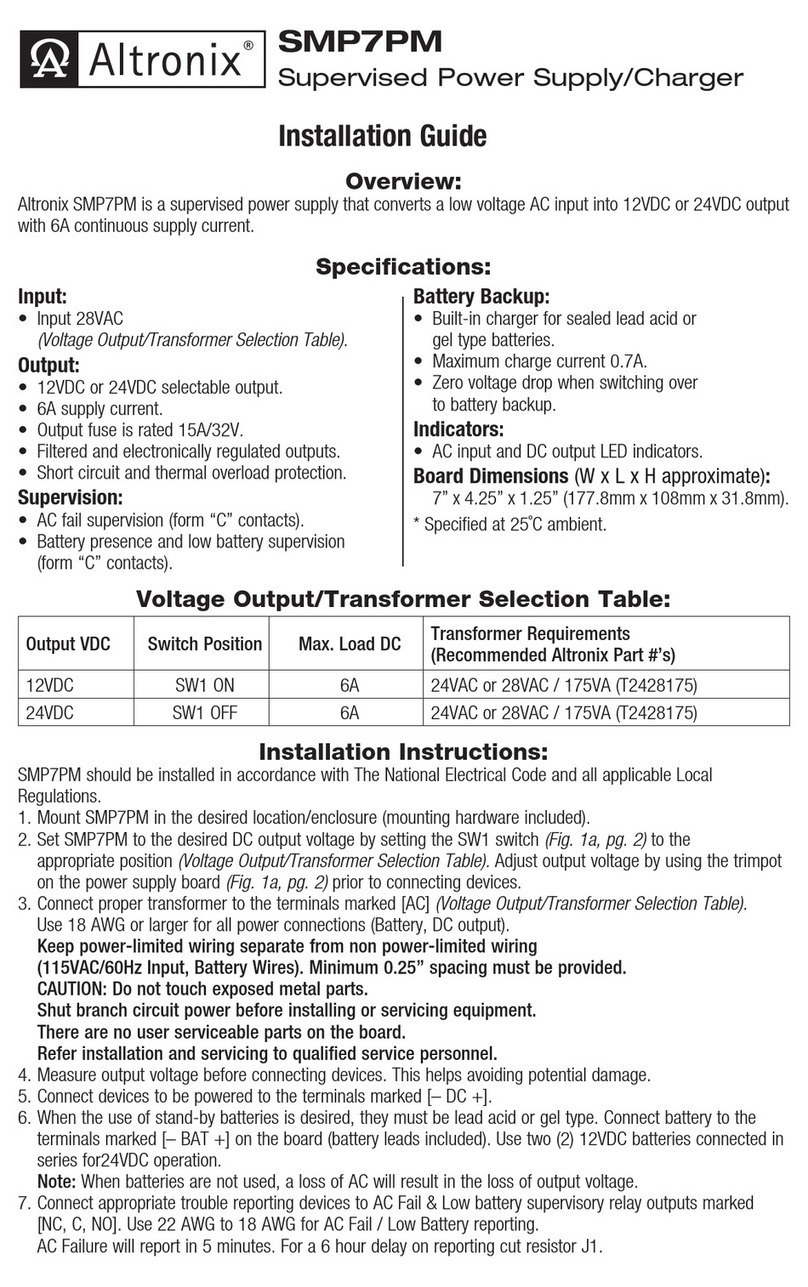
Altronix
Altronix SMP7PM installation guide
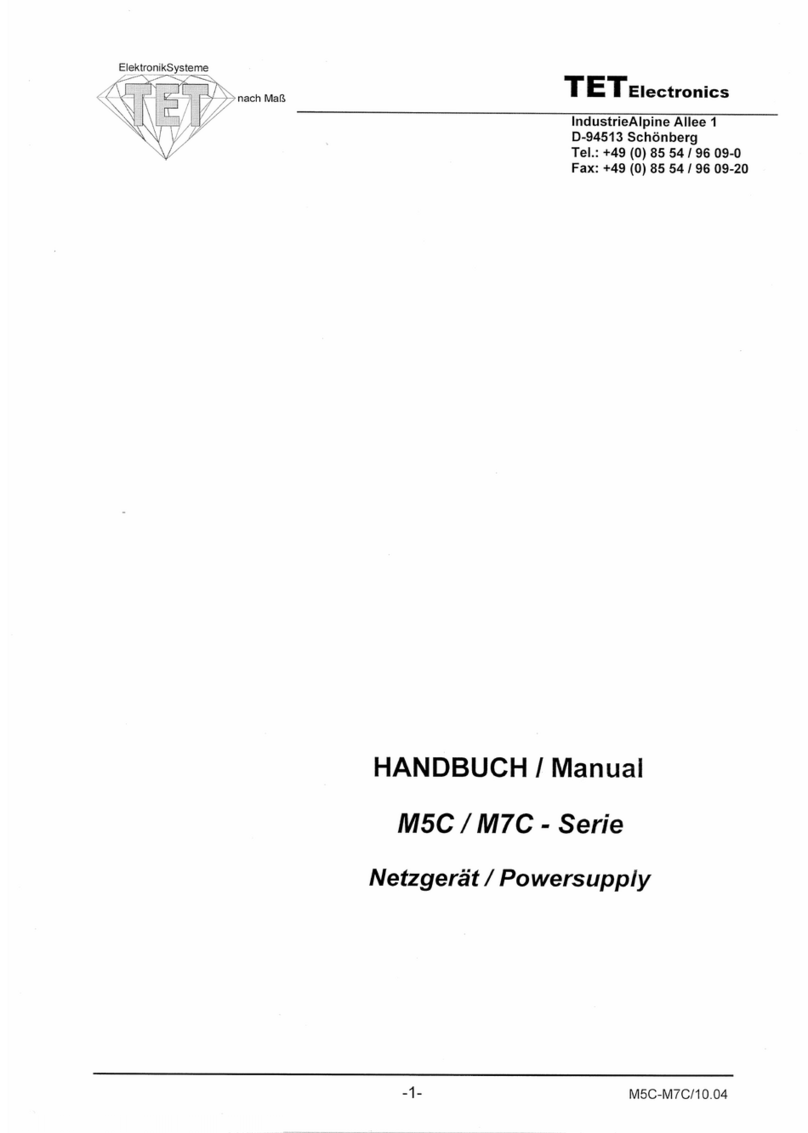
TET Electronics
TET Electronics M5C Series manual
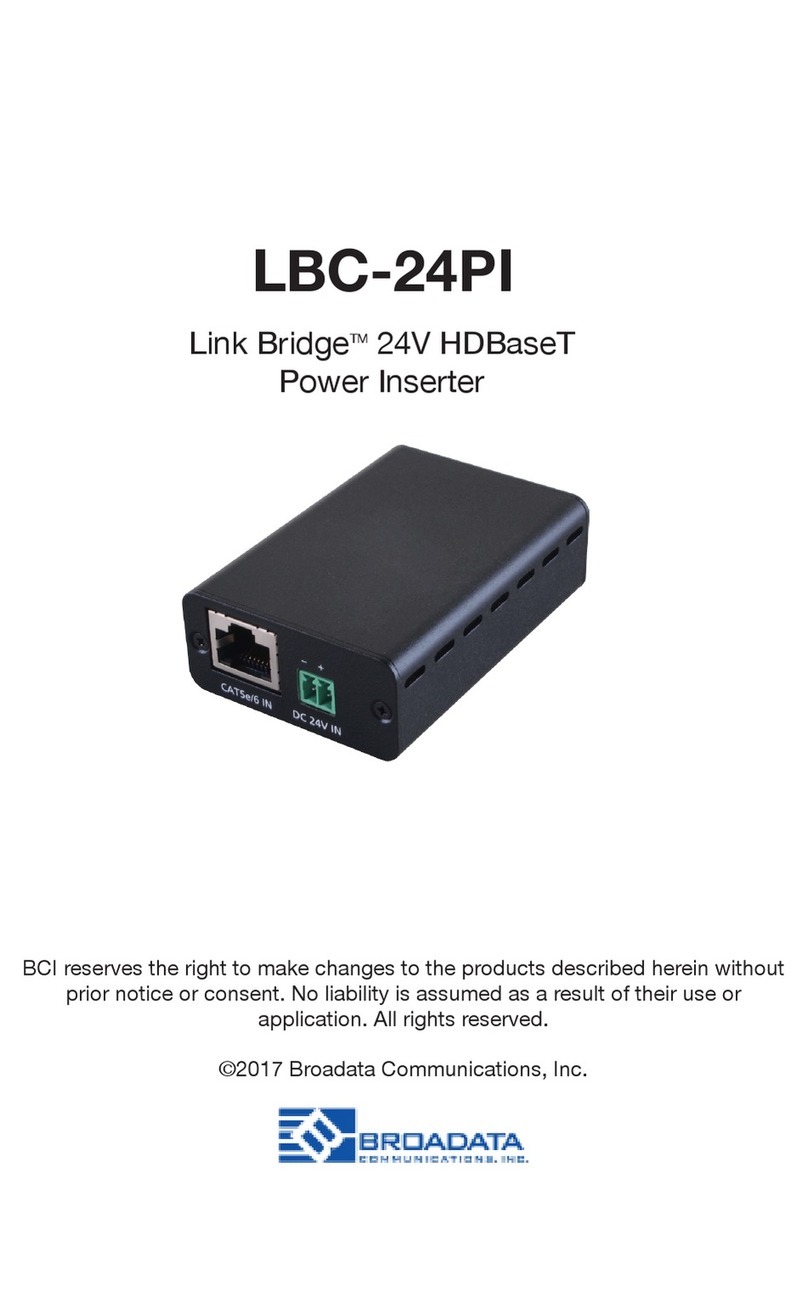
Broadata Communications
Broadata Communications Link Bridge LBC-24PI user manual
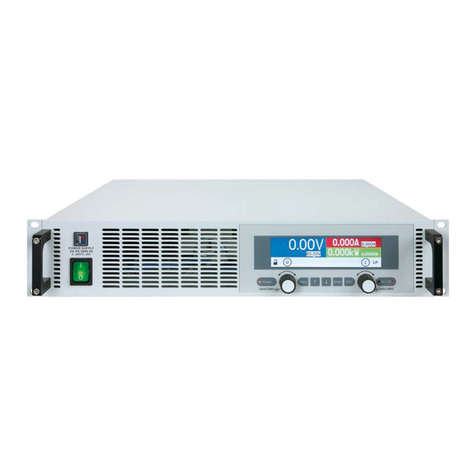
Elektro-Automatik
Elektro-Automatik PS 9040-40 2U operating guide

Delta Elektronika
Delta Elektronika ES300 Series manual
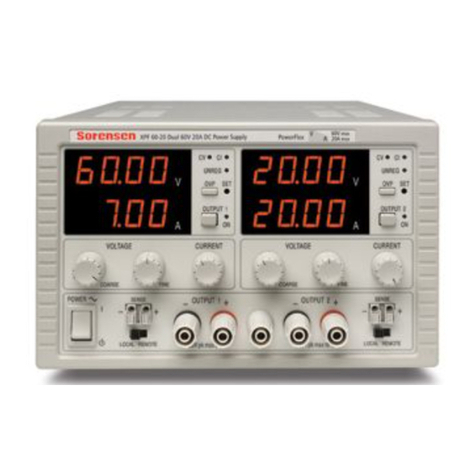
Xantrex
Xantrex XPF 60-20 operating manual
